Variations of Carbon Monoxide Concentrations in the Megacity of São Paulo from 2000 to 2015 in Different Time Scales
Abstract
:1. Introduction
2. Data and Method
2.1. Characterization of Monitoring Stations
2.2. Data
3. Results and Discussion
Annual Evolution and Seasonal, Diurnal Cycle
4. Conclusions
Supplementary Materials
Acknowledgments
Author Contributions
Conflicts of Interest
References
- Brazilian Institute of Geography and Statistics. IBGE 2014: Brazilian Census; Brazilian Institute of Geography and Statistics: Paulo Rabello de Castro, Brazil, 2015.
- Environmental Agency of the State of São Paulo. CETESB: Air Quality Report in São Paulo—2015; Environmental Agency of the State of São Paulo: São Paulo, Brazil, 2016.
- Finlayson-Pitts, B.J.; Pitts, J.N. Chemistry of the Upper and Lower Atmosphere—Theory, Experiments, and Applications, 1st ed.; Academic Press: San Diego, CA, USA, 2000. [Google Scholar]
- Wofsy, S.C.; McConnell, J.C.; McElroy, M.B. Atmospheric CH4, CO, and CO2. J. Geophys. Res. 1972, 77, 4477–4493. [Google Scholar] [CrossRef]
- Seinfeld, J.H.; Pandis, S.N. Atmospheric Chemistry and Physics: From Air Pollution to Climate Change, 3rd ed.; Wiley: Hoboken, NJ, USA, 2016. [Google Scholar]
- Horowitz, L.W.; Walters, S.; Mauzerall, D.L.; Emmons, L.K.; Rasch, P.J.; Granier, C.; Tie, X.; Lamarque, J.F.; Schultz, M.G.; Tyndall, G.S.; et al. A global simulation of tropospheric ozone and related tracers: description and evaluation of mozart, version 2: Mozart-2 description and evaluation. J. Geophys. Res. Atmos. 2003, 108. [Google Scholar] [CrossRef]
- Bakwin, P.S.; Tans, P.P.; Novelli, P.C. Carbon monoxide budget in the northern hemisphere. Geophys. Res. Lett. 1994, 21, 433–436. [Google Scholar] [CrossRef]
- Levy, H. Normal Atmosphere: Large Radical and Formaldehyde Concentrations Predicted. Science 1971, 173, 141–143. [Google Scholar] [CrossRef] [PubMed]
- Crutzen, P.J.; Zimmermann, P.H. The changing photochemistry of the troposphere. Tellus A 1991, 43, 136–151. [Google Scholar] [CrossRef]
- DeMore, W.B.; Sander, S.P.; Golden, D.M.; Hampson, R.F.; Kurylo, M.J.; Howard, C.J.; Ravishankara, A.R.; Kolb, C.E.; Molina, M.J. Chemical Kinetics and Photochemical Data for Use in Stratospheric Modeling. Evaluation No. 12. Available online: https://ntrs.nasa.gov/archive/nasa/casi.ntrs.nasa.gov/19970037557.pdf (accessed on 20 April 2017).
- Sze, N.D. Anthropogenic CO Emissions: Implications for the Atmospheric CO-OH-CH4 Cycle. Science 1977, 195, 673–675. [Google Scholar] [CrossRef] [PubMed]
- Jacobson, M.Z. Atmospheric Pollution: History, Science, and Regulation, 1st ed.; Cambridge University Press: Cambridge, UK, 2002. [Google Scholar]
- Isaksen, I.S.A.; Hov, Ø. Calculation of trends in the tropospheric concentration of O3, OH, CO, CH4 and NOx. Tellus Ser. B 1987, 39, 271–285. [Google Scholar] [CrossRef]
- Zander, R.; Demoulin, P.; Ehhalt, D.H.; Schmidt, U.; Rinsland, C.P. Secular increase of the total vertical column abundance of carbon monoxide above central Europe since 1950. J. Geophys. Res. 1989, 94, 11021. [Google Scholar] [CrossRef]
- Khalil, M.A.K.; Rasmussen, R.A. Global decrease in atmospheric carbon monoxide concentration. Nature 1994, 370, 639–641. [Google Scholar] [CrossRef]
- Thompson, A.M.; Cicerone, R.J. Atmospheric CH4, CO and OH from 1860 to 1985. Nature 1986, 321, 148–150. [Google Scholar] [CrossRef]
- Wang, C.; Prinn, R.G.; Sokolov, A. A global interactive chemistry and climate model: Formulation and testing. J. Geophys. Res. Atmos. 1998, 103, 3399–3417. [Google Scholar] [CrossRef]
- Kanakidou, M.; Crutzen, P.J. The photochemical source of carbon monoxide: Importance, uncertainties and feedbacks. Chemosphere Glob. Chang. Sci. 1999, 1, 91–109. [Google Scholar] [CrossRef]
- Jaffe, L.S. Ambient carbon monoxide and its fate in the atmosphere. J. Air Pollut. Control Assoc. 1968, 18, 534–540. [Google Scholar] [CrossRef] [PubMed]
- Cançado, J.E.D.; Braga, A.; Pereira, L.A.A.; Arbex, M.A.; Saldiva, P.H.N.; Santos, U.P. Clinical repercussions of exposure to atmospheric pollution. J. Bras. Pneumol. 2006, 32, S5–S11. [Google Scholar] [CrossRef] [PubMed]
- Raub, J.A.; Mathieu-Nolf, M.; Hampson, N.B.; Thom, S.R. Carbon monoxide poisoning—A public health perspective. Toxicology 2000, 145, 1–14. [Google Scholar] [CrossRef]
- Coburn, R.F. The carbon monoxide body stores. Ann. N. Y. Acad. Sci. 1970, 174, 11–22. [Google Scholar] [CrossRef] [PubMed]
- Medeiros, A.; Gouveia, N. Relationship between low birthweight and air pollution in the city of Sao Paulo, Brazil. Rev. Saúde Pública 2005, 39, 965–972. [Google Scholar] [CrossRef] [PubMed]
- Friedman, M.S. Impact of changes in transportation and commuting behaviors during the 1996 summer olympic games in atlanta on air quality and childhood asthma. JAMA 2001, 285, 897. [Google Scholar] [CrossRef] [PubMed]
- Li, Y.; Wang, W.; Kan, H.; Xu, X.; Chen, B. Air quality and outpatient visits for asthma in adults during the 2008 Summer Olympic Games in Beijing. Sci. Total Environ. 2010, 408, 1226–1227. [Google Scholar] [CrossRef] [PubMed]
- Morgenstern, V.; Zutavern, A.; Cyrys, J.; Brockow, I.; Koletzko, S.; Krämer, U.; Behrendt, H.; Herbarth, O.; von Berg, A.; Bauer, C.P.; et al. Atopic diseases, allergic sensitization, and exposure to traffic-related air pollution in children. Am. J. Respir. Crit. Care Med. 2008, 177, 1331–1337. [Google Scholar] [CrossRef] [PubMed]
- Oliveira, A.P.; Bornstein, R.D.; Soares, J. Annual and diurnal wind patterns in the city of são paulo. Water Air Soil Pollut. Focus 2003, 3, 3–15. [Google Scholar] [CrossRef]
- Bogo, H.; Gómez, D.R.; Reich, S.L.; Negri, R.M.; Román, E.S. Traffic pollution in a downtown site of Buenos Aires City. Atmos. Environ. 2001, 35, 1717–1727. [Google Scholar] [CrossRef]
- De Oliveira, A.P.; Machado, A.J.; Escobedo, J.F.; Soares, J. Diurnal evolution of solar radiation at the surface in the city of São Paulo: Seasonal variation and modeling. Theor. Appl. Climatol. 2002, 71, 231–249. [Google Scholar] [CrossRef]
- Sailor, D.J.; Fan, H. Modeling the diurnal variability of effective albedo for cities. Atmos. Environ. 2002, 36, 713–725. [Google Scholar] [CrossRef]
- Oke, T.R. Boundary Layer Climates, 2rd ed.; Routledge: New York, NY, USA, 1988. [Google Scholar]
- Cai, X.M. Large-eddy simulation of the convective boundary layer over an idealized patchy urban surface. Q. J. R. Meteorol. Soc. 1999, 125, 1427–1444. [Google Scholar] [CrossRef]
- Martins, M.H.R.B.; Anazia, R.; Guardani, M.L.G.; Lacava, C.I.V.; Romano, J.; Silva, S.R. Evolution of air quality in the Sao Paulo metropolitan area and its relation with public policies. Int. J. Environ. Pollut. 2004, 22, 430. [Google Scholar] [CrossRef]
- Carvalho, V.S.B.; Freitas, E.D.; Martins, L.D.; Martins, J.A.; Mazzoli, C.R.; Andrade, M.F. Air quality status and trends over the Metropolitan Area of São Paulo, Brazil as a result of emission control policies. Environ. Sci. Policy 2015, 47, 68–79. [Google Scholar] [CrossRef]
- Martins, L.D.; Martins, J.A.; Freitas, E.D.; Mazzoli, C.R.; Gonçalves, F.L.T.; Ynoue, R.Y.; Hallak, R.; Albuquerque, T.T.A.; Andrade, M.F. Potential health impact of ultrafine particles under clean and polluted urban atmospheric conditions: A model-based study. Air Qual. Atmos. Health 2010, 3, 29–39. [Google Scholar] [CrossRef] [PubMed]
- Orlando, J.P.; Alvim, D.S.; Yamazaki, A.; Corrêa, S.M.; Gatti, L.V. Ozone precursors for the São Paulo Metropolitan Area. Sci. Total Environ. 2010, 408, 1612–1620. [Google Scholar] [CrossRef] [PubMed]
- Alvim, D.S.; Gatti, L.V.; Corrêa, S.M.; Chiquetto, J.B.; Rossatti, C.S.; Pretto, A.; Santos, M.H.; Yamazaki, A.; Orlando, J.P.; Santos, G.M. Main ozone-forming VOCs in the city of Sao Paulo: Observations, modelling and impacts. Air Qual. Atmos. Health 2016. [Google Scholar] [CrossRef]
- Massambani, O.; Andrade, F. Seasonal behavior of tropospheric ozone in the Sao Paulo (Brazil) Metropolitan Area. Atmos. Environ. 1994, 28, 3165–3169. [Google Scholar] [CrossRef]
- Chiquetto, J.B.; Silva, M.E.S. Sao Paulo’s “Surface Ozone Layer” and the Atmosphere, 1st ed.; VDM Verlag Dr Müller: Saarbrücken, Germany, 2010; Volume 1. [Google Scholar]
- Gallardo, L.; Escribano, J.; Dawidowski, L.; Rojas, N.; Andrade, M.F.; Osses, M. Evaluation of vehicle emission inventories for carbon monoxide and nitrogen oxides for Bogotá, Buenos Aires, Santiago, and São Paulo. Atmos. Environ. 2012, 47, 12–19. [Google Scholar] [CrossRef]
- Vivanco, M.G.; Andrade, M.F. Validation of the emission inventory in the Sao Paulo Metropolitan Area of Brazil, based on ambient concentrations ratios of CO, NMOG and NOx and on a photochemical model. Atmos. Environ. 2006, 40, 1189–1198. [Google Scholar] [CrossRef]
- Seiler, W.; Giehl, H.; Brunke, E.-G.; Halliday, E. The seasonality of CO abundance in the Southern Hemisphere. Tellus B 1984, 36B, 219–231. [Google Scholar] [CrossRef]
- Badr, O.; Probert, S.D. Sources of atmospheric carbon monoxide. Appl. Energy 1994, 49, 145–195. [Google Scholar] [CrossRef]
- Logan, J.A.; Prather, M.J.; Wofsy, S.C.; McElroy, M.B. Tropospheric chemistry: A global perspective. J. Geophys. Res. 1981, 86, 7210. [Google Scholar] [CrossRef]
- Mao, J.; Ren, X.; Chen, S.; Brune, W.H.; Chen, Z.; Martinez, M.; Harder, H.; Lefer, B.; Rappenglück, B.; Flynn, J.; Leuchner, M. Atmospheric oxidation capacity in the summer of Houston 2006: Comparison with summer measurements in other metropolitan studies. Atmos. Environ. 2010, 44, 4107–4115. [Google Scholar] [CrossRef]
- McCormick, R.A.; Xintaras, C. Variation of carbon monoxide concentrations as related to sampling interval, traffic and meteorological factors. J. Appl. Meteorol. 1962, 1, 237–243. [Google Scholar] [CrossRef]
- Comrie, A.C.; Diem, J.E. Climatology and forecast modeling of ambient carbon monoxide in Phoenix, Arizona. Atmos. Environ. 1999, 33, 5023–5036. [Google Scholar] [CrossRef]
- Chiquetto, J.B.; Ynoue, R.Y.; Cabral-Miranda, W.; Silva, M.E.S. Changes in air pollution due to the implementation of urban parks in megacities: Observations and modelling. BPG 2016, 95, 1–24. [Google Scholar]
- Kunzli, N.; Bridevaux, P.O.; Liu, L.J.S.; Garcia-Esteban, R.; Schindler, C.; Gerbase, M.W.; Sunyer, J.; Keidel, D.; Rochat, T. Traffic-related air pollution correlates with adult-onset asthma among never-smokers. Thorax 2009, 64, 664–670. [Google Scholar] [CrossRef] [PubMed]
- U.S. Environmental Protection Agency. Final Assessment: Integrated Science Assessment for Carbon Monoxide; U.S. Environmental Protection Agency: Washington, DC, USA, 2010.
- Novelli, P.C. Reanalysis of tropospheric CO trends: Effects of the 1997–1998 wildfires. J. Geophys. Res. 2003, 108. [Google Scholar] [CrossRef]
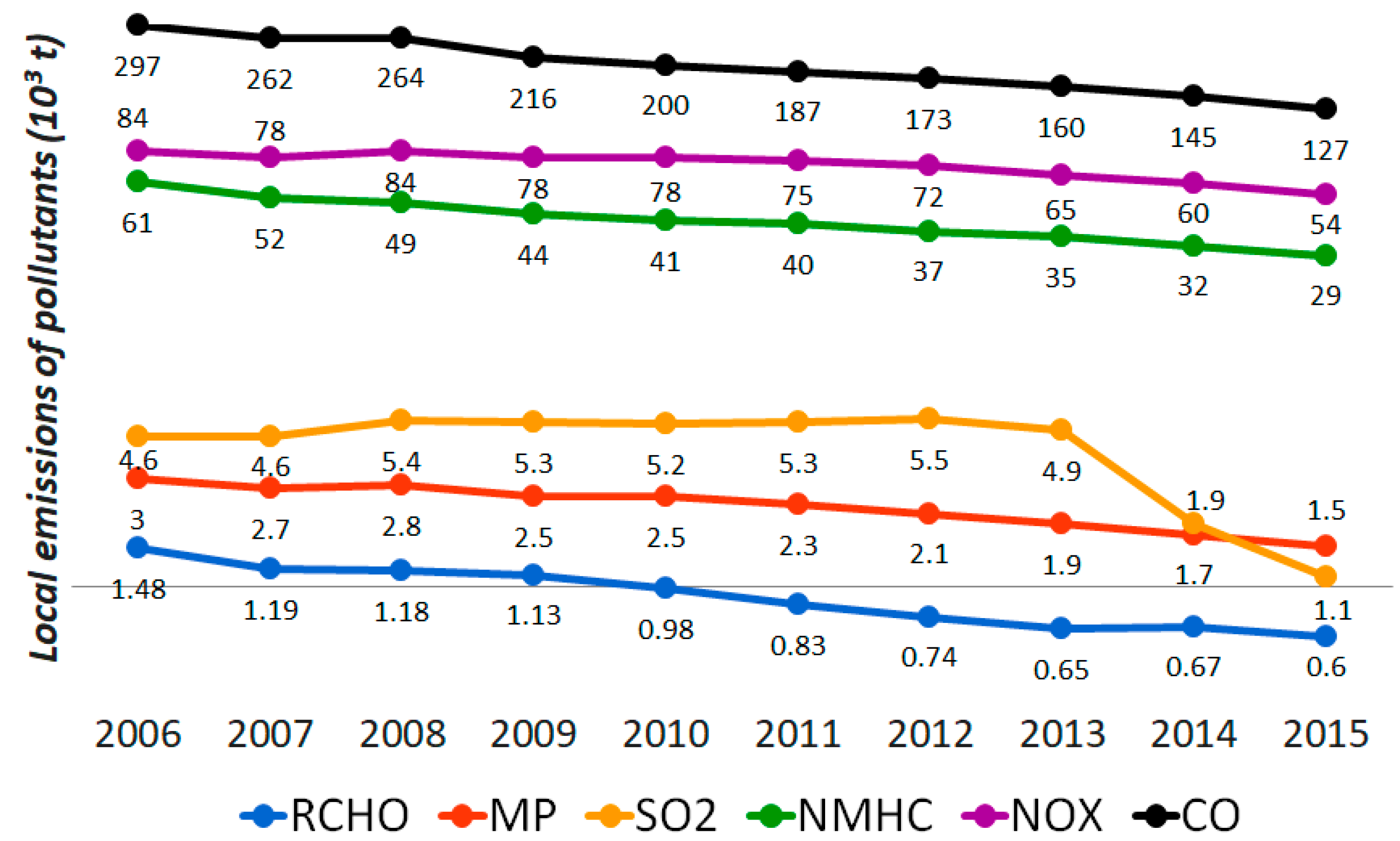
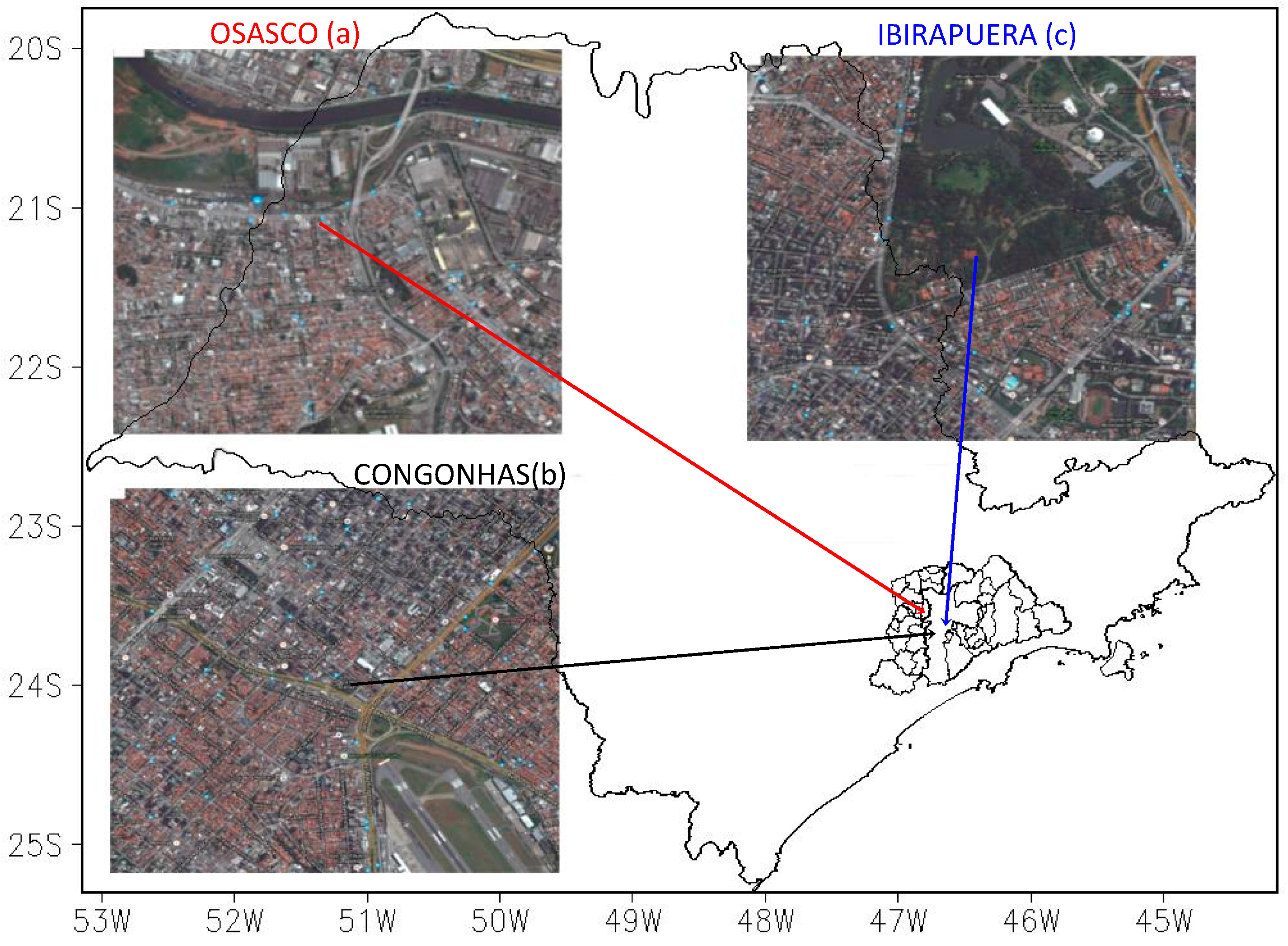
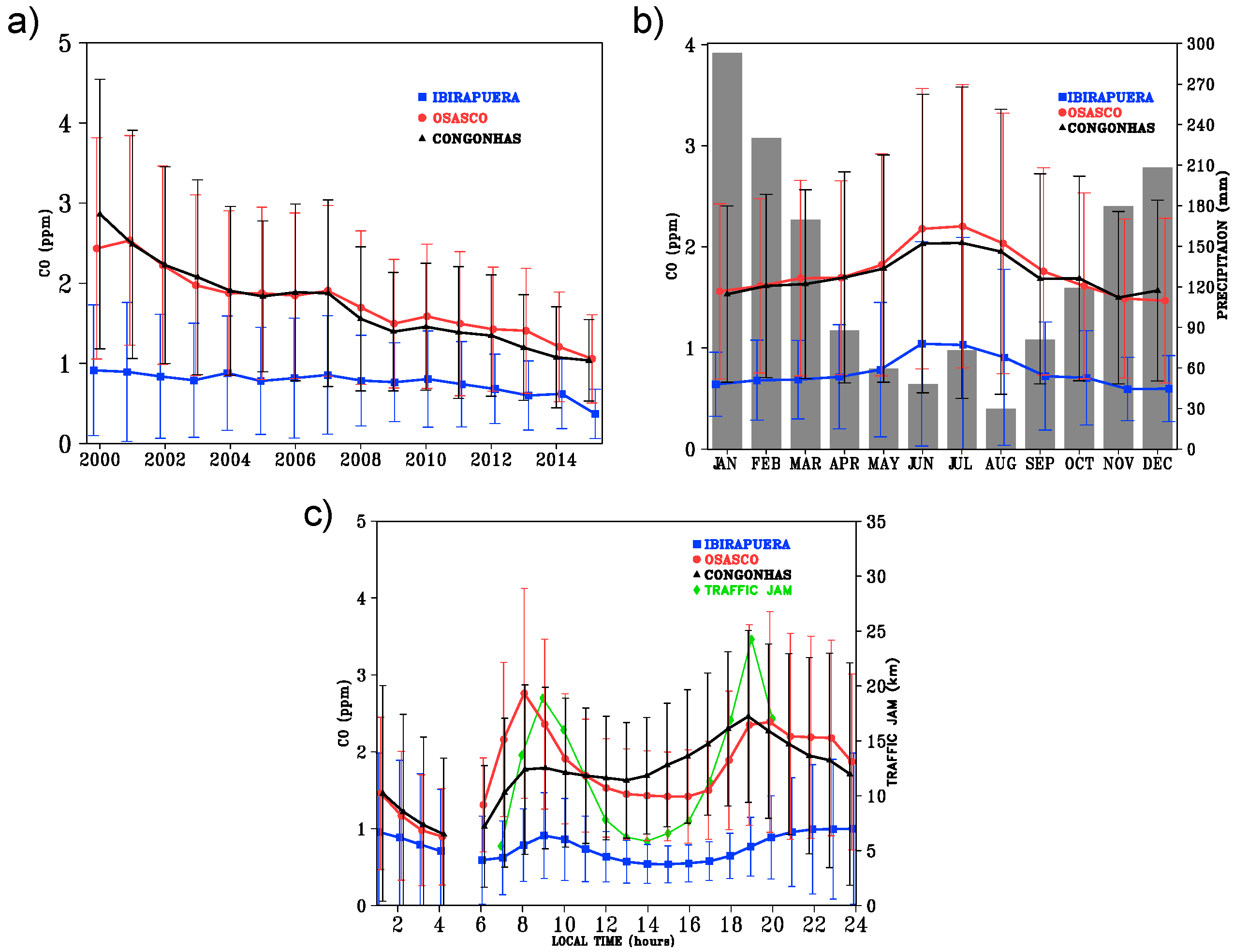
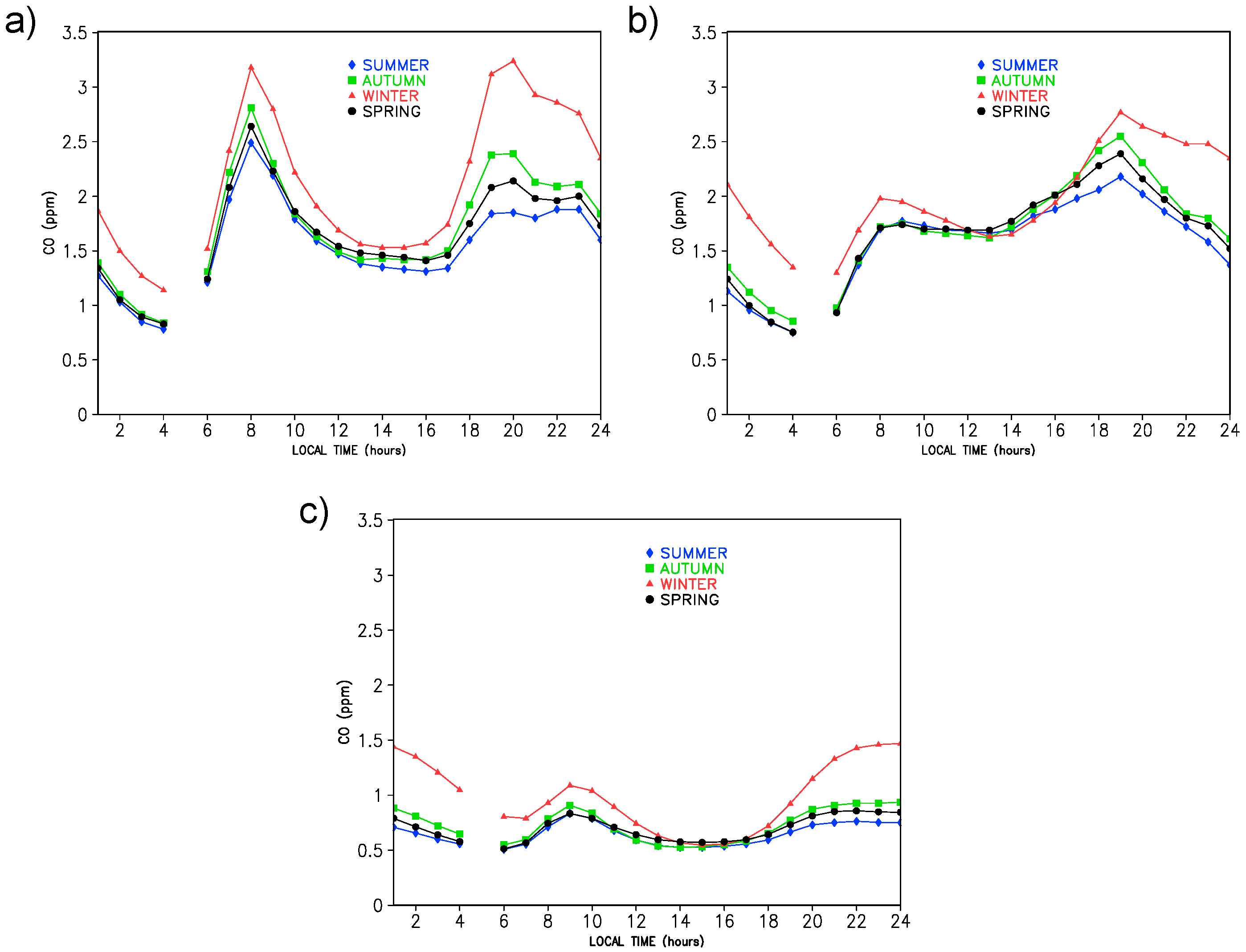
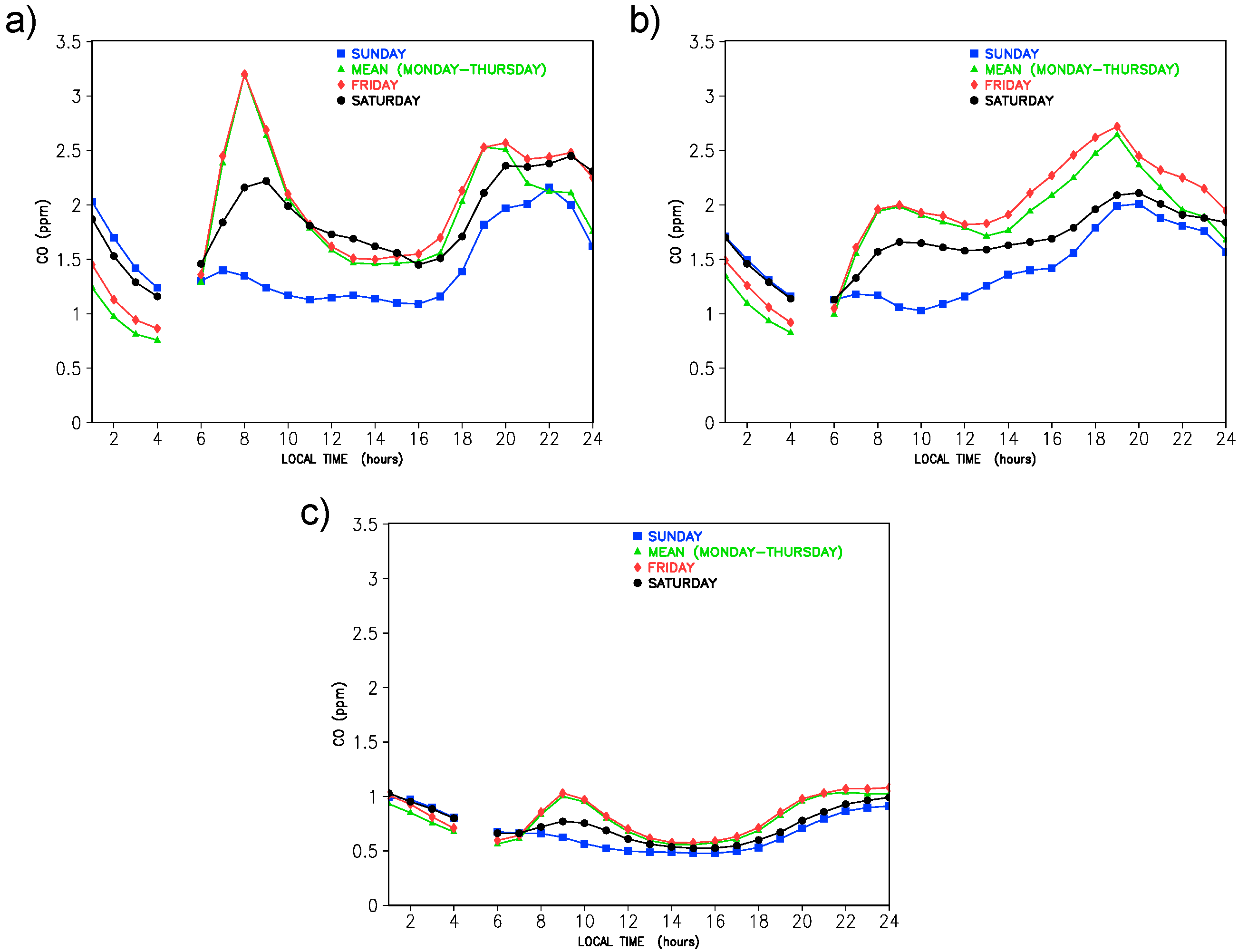
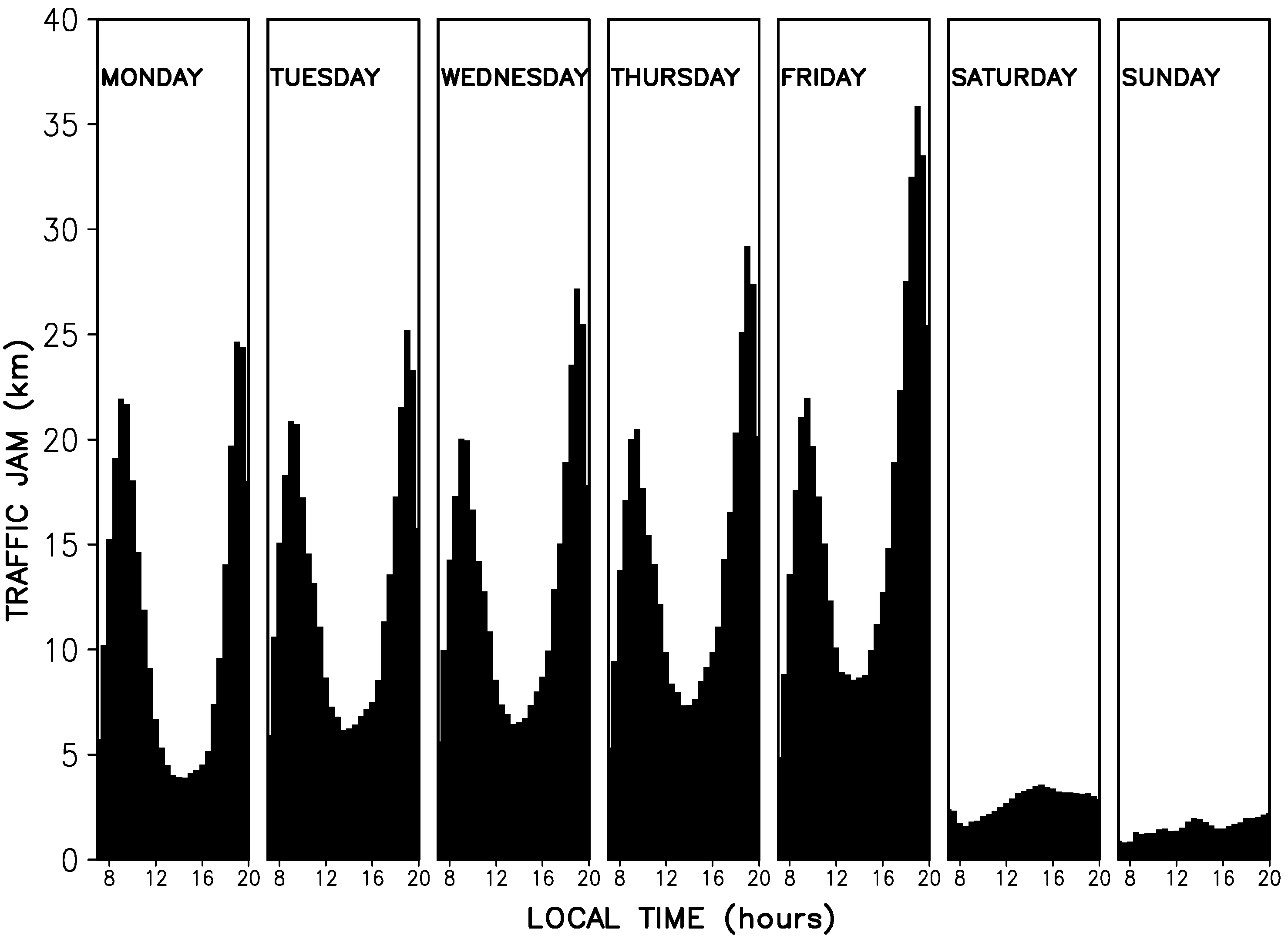
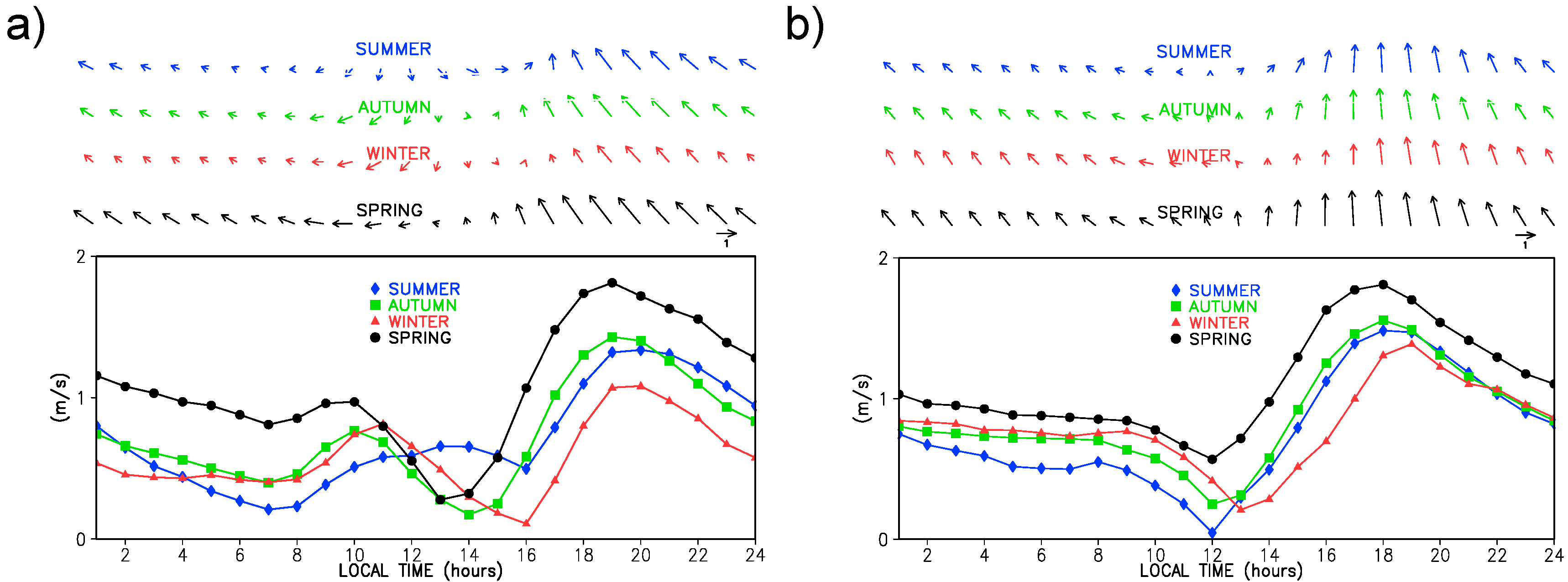
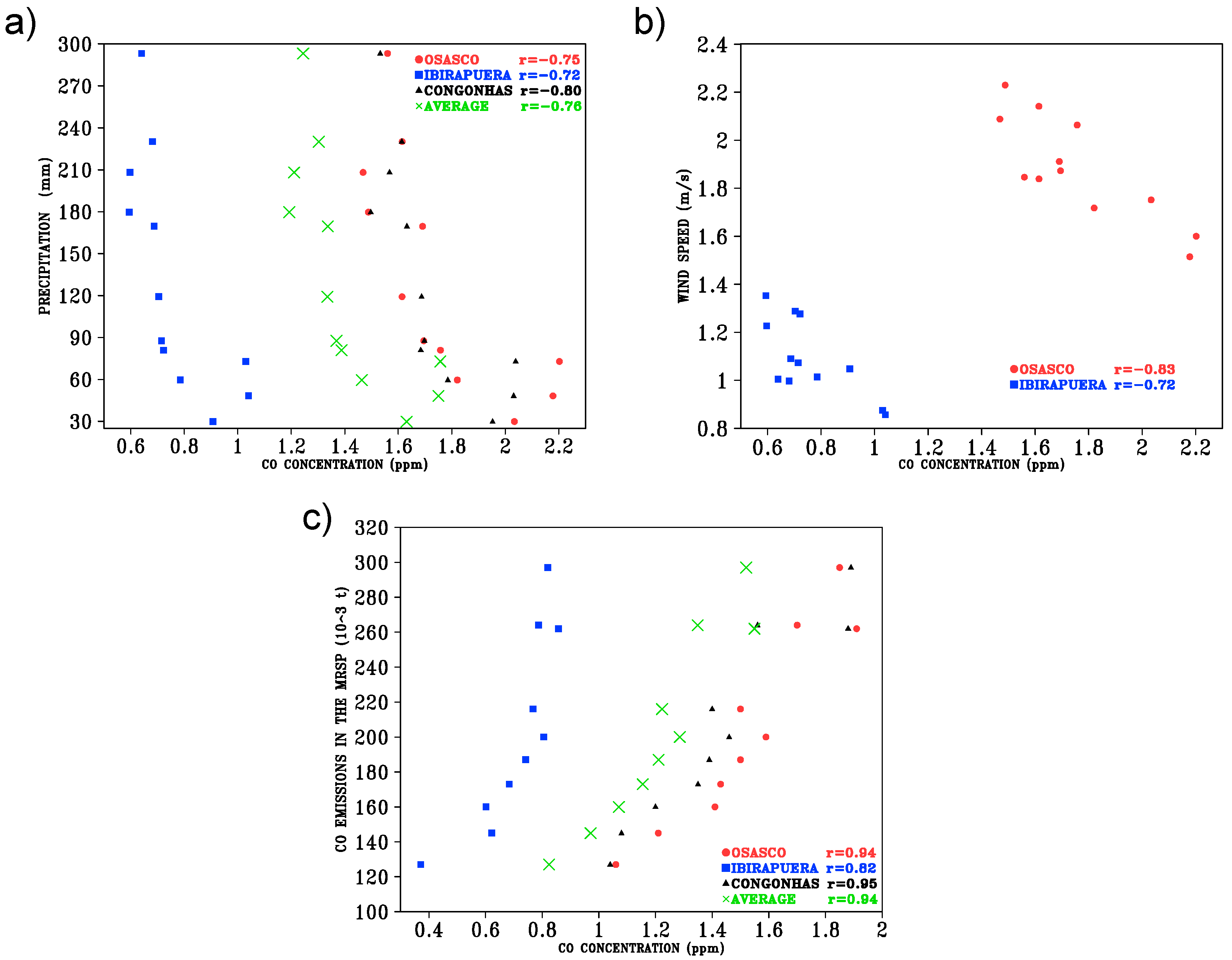
| Category | Fuel | Emission (1000 t/Year) | |||||
|---|---|---|---|---|---|---|---|
| Automobiles | CO | HC | NOx | PM | SOx | ||
| Gasoline C | 69.16 | 14.21 | 8.79 | 0.04 | 0.19 | ||
| Hydrated Ethanol | 14.01 | 2.62 | 1.13 | na | na | ||
| Flex-gasoline C | 9.59 | 3.93 | 1.04 | 0.02 | 0.11 | ||
| Hydrated flex-ethanol | 11.09 | 3.54 | 0.95 | na | na | ||
| Light commercial vehicles | Gasoline C | 13.19 | 2.36 | 1.30 | 0.007 | 0.04 | |
| Hydrated Ethanol | 0.89 | 0.17 | 0.08 | na | na | ||
| Flex-gasoline C | 1.38 | 0.70 | 0.17 | 0.003 | 0.02 | ||
| Hydrated flex-ethanol | 1.98 | 0.57 | 0.21 | na | na | ||
| Diesel | 1.05 | 0.27 | 4.35 | 0.18 | 0.32 | ||
| Semi-Light | 0.23 | 0.07 | 1.25 | 0.06 | 0.03 | ||
| Trucks | Light | Diesel | 1.01 | 0.31 | 5.73 | 0.24 | 0.18 |
| Medium Semi-Heavy Heavy | 0.66 0.81 | 0.22 0.19 | 3.84 4.64 | 0.19 0.14 | 0.10 0.17 | ||
| 0.74 | 0.20 | 4.60 | 0.14 | 0.18 | |||
| Buses | Urban Mini-bus | Diesel | 2.44 0.17 | 0.55 0.04 | 12.72 0.92 | 0.37 0.02 | 0.01 0.001 |
| Intercity | 0.23 | 0.07 | 1.48 | 0.02 | 0.06 | ||
| Motorcycles | Gasoline C Flex-Gasoline C | 33.52 0.53 | 4.67 0.09 | 1.08 0.04 | 0.07 0.003 | 0.13 0.010 | |
| Hydrated flex-ethanol | 0.22 | 0.05 | 0.02 | na | na | ||
| Total Vehicular Emission (2014) | 162.90 | 34.82 | 54.33 | 1.48 | 1.56 | ||
| Industrial Process Operation (2008) | 4.18 1 | 5.6 2 | 26.10 2 | 3.57 2 | 5.59 1 | ||
| Number of Inventoried Industries | (62) | (124) | (162) | (193) | (146) | ||
| Liquid fuel base (2008) | - | 3.68 2 | - | - | - | ||
| (9 sites) | |||||||
| TOTAL | 167.08 | 44.10 | 80.43 | 5.05 | 7.15 | ||
| Station | Latitude (South) | Longitude (West) | Altitude (m) |
|---|---|---|---|
| Osasco | 23°31′35″ | 46°47′31″ | 740 |
| Congonhas | 23°36′29″ | 46°39′37″ | 760 |
| Ibirapuera | 23°34′55″ | 46°39′25″ | 750 |
© 2017 by the authors. Licensee MDPI, Basel, Switzerland. This article is an open access article distributed under the terms and conditions of the Creative Commons Attribution (CC BY) license (http://creativecommons.org/licenses/by/4.0/).
Share and Cite
Rozante, J.R.; Rozante, V.; Souza Alvim, D.; Ocimar Manzi, A.; Barboza Chiquetto, J.; Siqueira D’Amelio, M.T.; Moreira, D.S. Variations of Carbon Monoxide Concentrations in the Megacity of São Paulo from 2000 to 2015 in Different Time Scales. Atmosphere 2017, 8, 81. https://doi.org/10.3390/atmos8050081
Rozante JR, Rozante V, Souza Alvim D, Ocimar Manzi A, Barboza Chiquetto J, Siqueira D’Amelio MT, Moreira DS. Variations of Carbon Monoxide Concentrations in the Megacity of São Paulo from 2000 to 2015 in Different Time Scales. Atmosphere. 2017; 8(5):81. https://doi.org/10.3390/atmos8050081
Chicago/Turabian StyleRozante, José Roberto, Vinícius Rozante, Débora Souza Alvim, Antônio Ocimar Manzi, Júlio Barboza Chiquetto, Monica Tais Siqueira D’Amelio, and Demerval Soares Moreira. 2017. "Variations of Carbon Monoxide Concentrations in the Megacity of São Paulo from 2000 to 2015 in Different Time Scales" Atmosphere 8, no. 5: 81. https://doi.org/10.3390/atmos8050081






